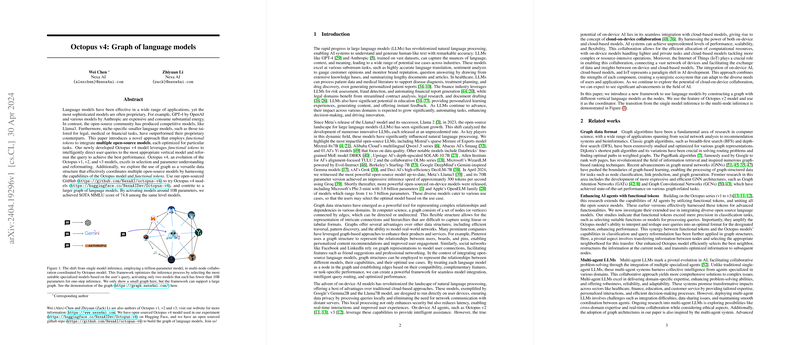Exploring Octopus v4: A Multi-Model AI Framework
Introduction to Octopus v4
Octopus v4 represents a sophisticated advancement in the AI research domain, specifically with LLMs. Unlike standard singular large models such as GPT-4 or Anthropic, which operate within a single, expansive framework, Octopus v4 introduces a more compartmentalized approach. This model intelligently integrates multiple smaller, open-source models, each tailored to specific tasks. For example, some models are specialized for healthcare, legal, or financial sectors. By leveraging functional tokens, Octopus v4 efficiently navigates and utilizes the best suited model for any given query, enhancing both performance and resource utilization.
Why Octopus v4 Matters
Efficient Resource Use: One of the major challenges with massive LLMs is their substantial demand for computing power and energy. Octopus v4, with its multi-model framework, only activates necessary models during a query. This approach uses significantly less computational power compared to engaging a gigantic trillion-parameter model for every task.
Enhanced Accuracy with Specialization: Previous iterations like Octopus v1 through v3 have laid the groundwork, but Octopus v4 improves the capability to select and route queries to the most suitable specialized model. This specificity boosts the accuracy and relevance of the outputs, particularly for niche tasks where specialized knowledge is key.
Open-Source Availability: The Octopus v4 is open-source, which isn't just a nod towards transparency but also a significant step toward democratizing AI technology. The ability for researchers and developers to access state-of-the-art AI capabilities without prohibitive costs can accelerate innovation and application across various sectors.
Graph-Based Coordination: The use of a graph structure to manage the relationships and interactions between different models adds a layer of sophistication. This approach allows Octopus v4 to more effectively route queries to the appropriate models and facilitates easier scaling and integration of additional models.
Practical Implications and Theoretical Significance
- Versatility Across Industries: The architecture of Octopus v4 allows it to be applied in diverse fields – from medical diagnostics and legal advisement to personalized education and financial analysis. This flexibility promises widespread industry transformations, where businesses and institutions can leverage specific AI capabilities tailored to their needs without the overhead of managing gigantic AI models.
- Support for Edge Computing: The Octopus framework aligns well with the shift towards on-device AI processing. This can result in faster response times and reduced cloud server dependencies, further enhancing privacy and data security for sensitive applications.
- Community-Driven Enhancements: With its open-source nature and the harnessing of a wide array of smaller models, Octopus v4 encourages a community-driven approach to AI development. Researchers and tech enthusiasts can contribute to the platform, propose improvements, and customize the models for better personal or organizational use.
Future Prospects
The continuous evolution of the Octopus models and their increasing integration capabilities hint at a future where AI can seamlessly combine the strengths of various specialized models for complex, multi-faceted analyses and tasks. Future versions might see even greater efficiencies and capabilities, possibly integrating machine learning models beyond language processing, such as visual recognition and sensory data interpretation.
In summary, Octopus v4 stands out not just for its technical advancements but for its strategic shift towards a more sustainable, versatile, and community-friendly AI ecosystem. This can potentially redefine how tasks requiring specialized knowledge are approached and executed AI systems, making advanced AI tools more accessible to a broader range of users and developers.
